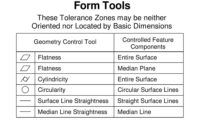Quality 101: Making GD&T Work

The GD&T Approach Source: Multi Metrics
Why is Geometric Dimensioning and Tolerancing (GD&T) so often considered “Grim, Depressing and Troublesome,” when, in so many ways, it is the “Greatest Design Tool” and essential for cost-effective manufacturing and reliable metrology, assembly and operation?
There are several reasons:
- It is complex , but in fact no more complex than the imperfect real world of machine part geometry.
- It is only used now and then, and if you do not use it all the time, you’ll definitely lose it down the line.
- Its application is poorly set forth in various standards-ASME Y14.5 and ISO 1101-and as a result, GD&T is all too commonly used to “decorate” computer-aided design (CAD) models for later “interpretation” rather than to “encode” feature functions for later “decoding.”
- to research, refine and ultimately encode the function of each feature of a machine part by imposing function guaranteeing limits on imperfection.
- to enable truly scientific tolerance stack-up analysis, and therefore to guarantee assembly and operation prior to model release.
- to specify strictly decodable requirements for manufacturing.
- to enable logic-based coordinate metrology and therefore, truly meaningful 3-D manufacturing process feedback and management.
- fool ourselves into believing we have defined a part which can be guaranteed to assemble and operate, when in fact it may fail in all respects.
- burden our machine shops with misinformation, and lay the blame on them for manufacturing useless parts.
- increase the prices quoted by machine shops for the reasons stated in the previous item.
- force metrologists to interpret drawings because the so-called code is in fact pure decoration.
- waste time and money, and ultimately hold GD&T responsible for our problems, which are actually only due to its misuse.

The Classical Approach. Source: Multi Metrics
Application
The two drawings, one classical and the other GD&T encoded, enable a demonstration of their contrasting abilities to assess and guarantee assembly and operation before drawing release, as well as their abilities to define precise manufacturing, metrology and operational objectives. Given that the illustrated part serves as a staging fixture for the primary purpose of tightly mutually orienting and locating six Ø19.6±0.2 x 70 mm long pins perpendicular to its base plane, take a look at the comparative clarity with which the two alternatives encode its functions.The Classical Approach merely implies the stated functional objectives by using tight tolerances on relative relationships and loose tolerances on global relationships, and further complicates matters by failing to define a reliable method for establishing the implied, asymmetric coordinate system in a part which has three planes of symmetry. The classical drawing therefore makes tolerance stack-up analysis, manufacturing, metrology and assembly entirely dependent on tribal understandings.
The GD&T Approach specifies the functional objectives explicitly using a loose Position control to coarsely locate the bore pattern relative to the periphery of the fixture, and a tight Position control to impose the more critical mutual relationship of the bores. It does so using a datum feature based, precisely defined coordinate systems of which ABC is still asymmetric, but is now referenced to a part whose symmetry has been broken by the addition of a chamfer. The GD&T drawing also imposes a Projection modifier to further guarantee functionality, and is therefore uniquely decodable for reliable, function based tolerance stack-up analysis, manufacturing, metrology and assembly.
Fulfilling Promises
Given the technical and financial contributions GD&T can make if properly applied, how can we make it fulfill its promises? Whereas most efforts to improve the proper encoding and decoding of GD&T are focused on training, most users do not have the time or even the desire to become adequately expert in GD&T. They simply want to use it, and over time, their expertise fades and tribal understandings take over again. In order to overcome the barriers of complexity and sporadic use, and enable companies to profit from GD&T, there is no alternative but to largely automate the encoding and decoding processes.This has been successfully, even if not widely accomplished in metrology, where some software systems are able to download a CAD model with truly functional GD&T and automatically turn it into a full-fledged inspection process with essentially no operator involvement.
The same may soon be successfully accomplished in tolerance stack-up analysis, again however, only given truly functional GD&T code. The greatest problem remains how to at least partially automate the encoding process to ensure the code is truly functional and syntactically correct in the first place.
Some CAD companies have shown interest, and some have even begun to attack the problem. But they are dragging their feet because management does not hear users banging on their doors, and users do not bang on their doors because they cannot imagine that such things might be possible.
In fact, artificial intelligence support for encoding GD&T is eminently possible after GD&T has been reduced to a thoroughly rule-based system. Since this is essentially in hand, it is time to raise a din to get on with it. The promises of GD&T can only be realized with artificially intelligent, such as smart GD&T encoding technology.
Looking for a reprint of this article?
From high-res PDFs to custom plaques, order your copy today!



